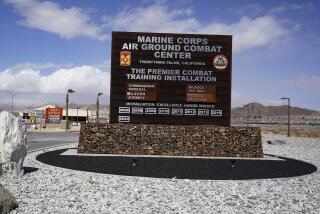Bets Riding on a Shore Thing : Training: Marines at Camp Pendleton are participating in an intensive program teaching them to handle amphibious assault vehicles.
- Share via
CAMP PENDLETON — If and when Marines storm the beaches to liberate Kuwait, most will be taken ashore by a toady-looking 41,000-pound craft handled by crews intensively trained here.
Last August, when the first Marines were deployed to the Middle East, the Amphibious Vehicle School at the world’s largest amphibious assault training base shifted into overdrive to prepare for war.
“We’re going to train more of these guys in four months than we would during a normal year,” Col. Nick Hoskot, commanding officer of the Schools Battalion, said during an exercise Monday.
What had been a six-week course of eight-hour days has become a 23-day course of 10-hour days, during which an increased number of crews are being trained for combat in the Gulf War.
Military experts are virtually certain that Marines will stage a dramatic landing on enemy-held shores, and although that view is still somewhat speculative, there would be a lot riding on an amphibious assault.
Beyond the success or failure, the operation would put the Marines at center stage of the conflict in a high-stakes test of their combat reputation.
“It’s symbolic of what we do; our primary mission is amphibious assault, and this,” said Hoskot, glancing at a landing craft, “is how we get there.”
After the crews are trained on the sprawling base south of San Clemente, they are assigned to Marine units based elsewhere. Hoskot and his officers do not know exactly what to anticipate in a fight with Iraqi forces, but the training emphasizes basic and adaptable skills.
The amphibious assault vehicle is a decidedly unromantic looking track-driven craft that carries up to 22 Marines loaded with combat equipment. It is usually armed with a .50-caliber machine gun and a 40-millimeter grenade launcher. It is handled by a three-man crew.
The Marine Corps has 1,100 of these vehicles, although how many are poised for action in the Gulf War has not been disclosed. Camp Pendleton will not divulge how many crew members are now being trained.
Monday was the start of four-day field operations that began with officers practicing coordination and communication with the ship that carries and releases the vehicles. Several amphibious assault vehicles landed amid a turbulent surf on Camp Pendleton’s shores.
Maj. Steve Warner, commanding officer of the Amphibious Vehicle School, said the craft is the workhorse of the corps’ amphibious arsenal. “These vehicles will lead and lift the assault force,” he said.
Other craft, including the high-powered Hovercraft, would play a key role in an assault from sea, but even so, the amphibious assault craft would lead the way.
The vehicles, which cost $900,000 each, can go over 15-foot swells, move at 7 knots (8.2 m.p.h.) through water and up to 45 m.p.h. on good terrain. (The speed drops to between 20 and 30 m.p.h. on difficult land.)
The speeds may not be great, but they are fast enough to exhilarate the crews. “It’s a thrill you can’t get doing anything else,” said Lance Cpl. Brandon Frisbie of Minnesota.
The plating on the vehicle can withstand small arms fire. The greatest fear, Hoskot said, is of mines and surface-to-surface missiles. The Marines are confident that the craft can operate through oil-coated waters.
No one knows for sure what to expect from Iraqi forces during an amphibious landing on Kuwaiti shores, but amphibious doctrine, simply put, “is to go where they aren’t,” Hoskot said.


